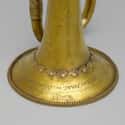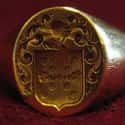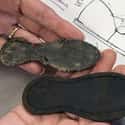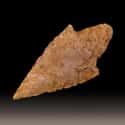(#10) A Trumpet Mouthpiece
A trumpet mouthpiece was discovered beneath the earth of Jamestown. It may have come from Nuremberg, Germany, where most trumpets of the 17th century were manufactured. No known English-made trumpet from the period exists. Regardless of its origin, the Jamestown trumpet may be the earliest trumpet found in America.
Trumpets have historically played an important role in a fort society, and James Fort was no exception. They were also used to announce the colonists' arrival at Native American camps. An early colonial governor, Thomas Dale, wrote a warning to Chief Powhatan that if he did not return runaway colonists or stolen items from Fort James, the colony's leaders would announce the start of a conflict with "our Drums and Trumpets."
(#3) A Signet Ring With A Shakespearean Connection
Along with the pottery, glass, and bones that have been discovered at Jamestown, some more precious items have appeared. One of the most intriguing is a brass signet ring, embossed with the image of an eagle with spread wings. The symbol was associated with the Strachey family of England. William Strachey was an early Jamestown colonist. He was an educated man and a playwright who moved within William Shakespeare's literary circle. He was also among the passengers of a ship destined for Jamestown, thought lost just prior to the Starving Time.
But Strachey's ship, the Sea Venture, wasn't lost. Instead, it got caught in a hurricane and blown off course. The ship landed, somewhat damaged, on Bermuda. The crew and passengers were stuck there all winter until they could repair the ship. When spring arrived, they loaded up the hold and sailed for Jamestown.
When the repaired Sea Venture reached Jamestown Island, the new arrivals discovered a small group of weak and emaciated settlers, a total of 60. The other ships which had come over with the Sea Venture had made it to Jamestown, swelling the population to around 500. But the Sea Venture had carried the food, seeds, and farming implements, along with firearms and related supplies for hunting or fort defense. Without them, the settlement had struggled.
The survivors begged the leadership from the Sea Venture to take them away from their horrible existence at James Fort, and it was decided that everyone would board the ship and return to England immediately. But as they were making their way down the James River and into the Chesapeake Bay, a group of ships was spied, carrying new colonists and fresh supplies. Everyone agreed to return and give Jamestown one more try.
When Strachey finally returned to England, he was known to regale his fellow poets and authors with stories from his adventures in Bermuda and Virginia. Shakespeare supposedly based his play The Tempest on the tale of the shipwrecked Sea Venture.
As for Strachey's ring, it's unclear whether he lost it during the one year he spent at Jamestown, or if he sold it and someone else lost it.
(#4) A Knight's Tomb
The crew at the Jamestown site unearthed a seemingly out-of-place object: an elaborate grave covering that appears to have belonged to a knight. Either someone wanted a special memorial for a family member, or an actual knight settled in Virginia during the 17th century.
Who could this mysterious knight be? Lord de la Warr, an early colonial governor, held a title, but there is little evidence to suggest he is the knight. Then there was Sir George Yeardley, who some historians believe is the strongest candidate for ownership of the knight's tomb of Jamestown. Yeardley served as governor and returned to England for a time to secure his knighthood.
Historians have studied letters and records of Yeardley's heirs for clues. One letter written by Yeardley's step-grandson mentions that the family would like to order a large, black marble tomb with the crest of Sir George Yeardley embossed on the cover. That suggests a possible connection with the knight's tomb, though the crest is missing.
While Yeardley seems to fit the profile for the mystery knight, the case will probably never be solved. For one thing, there is no way to determine the original site of the tomb. The stone was moved to serve as a paver in the aisle of the memorial church that was built at Jamestown in the early 20th century. It's also unclear whether any remains buried beneath its current location belonged to the original body.
(#2) A Child's Shoes
Believe it or not, even a few shoes survived the centuries buried in Jamestown pits and wells. Unearthed discoveries included a children's worn pair of shoes, constructed of goatskin leather. The condition of the shoes suggests only light wear. Perhaps a young child took his or her first steps in the New World in these very shoes.
Shoes were a mark of prestige, particularly for children, who typically went barefoot. So, the shoes either belonged to a child of a wealthy Jamestown family or a child of lesser status whose parents doted upon them.
(#5) The Remains Of A Teenage Settler And The Arrowhead That Ended Him
Archaeologists at Jamestown discovered the remains of a 14 or 15-year-old boy. The teen had a Native American arrowhead buried in the bone of his left leg, suggesting he was cut down in a fight. Skirmishes and battles with the Powhatan people were not unusual, but this burial happened very early after the arrival of the first colonists, in 1607. The boy also appears to have been hastily buried, due to the position of his body and the fact that the dirt covering him was completely lacking in any European artifacts. Some historians believe he was the colony's first fatality.
Both Captain John Smith and Captain Gabriel Archer wrote about an incident that occurred a mere two weeks after their arrival and the establishment of Jamestown. The men described how they had lost a young man in a skirmish with the Powhatans.
According to the Wisconsin Historical Society's American Journeys Collection, Captain Smith noted: "[The Native Americans] had ent'red the fort with our own men, which were then busied in setting corn... in which conflict most of the council was hurt, a boy slain."
(#9) A Lead-Riddled Body In A Military Sash
Four early Jamestown graves were discovered in the original church site's chancel, which was one of the most sacred areas in the church. Archeologists knew that the location indicated the high status of those buried in the graves. DNA testing and examination of the accompanying artifacts allowed researchers and scientists to identify the remains.
Captain William West was one of the four prominent colonists buried in the church chancel. He was only 24 when he perished during a 1610 skirmish with the Powhatan. He was discovered wearing the remains of an ornate, fringed military sash, which researchers concluded was probably silk and was decorated with silver fringe and spangles. West's remains also contain high levels of lead. Wealthy people of the 16th and 17th centuries used dishes and vessels made from silver and pewter, which were known to contain lead.
The other three men buried alongside West include Captain Gabriel Archer, Reverend Robert Hunt, and Sir Ferdinando Wainman.
New Random Displays Display All By Ranking
About This Tool
Jamestown is a colonial site in history in southeastern Virginia, it is the first British colony in North America. In 1607, 105 British arrived at Virginia and establish Jamestown, and the history of the United States began. In 1676, the Virginians who rebelled against the governor razed the city to the ground. In 1699, the state capital moved to Williamsburg and Jamestown fell into decline.
The original site in Jamestown was flooded by the river. It was not until 1994 that archaeologists unearthed a large number of cultural relics. It is now turned into a national historical park. The random tool shows 10 creepy and shocking historical items in Jamestown.
Our data comes from Ranker, If you want to participate in the ranking of items displayed on this page, please click here.
















